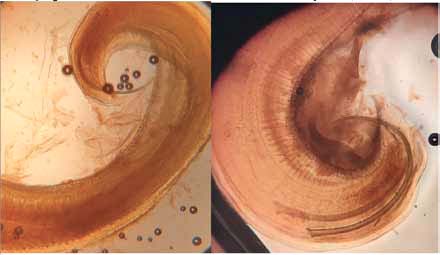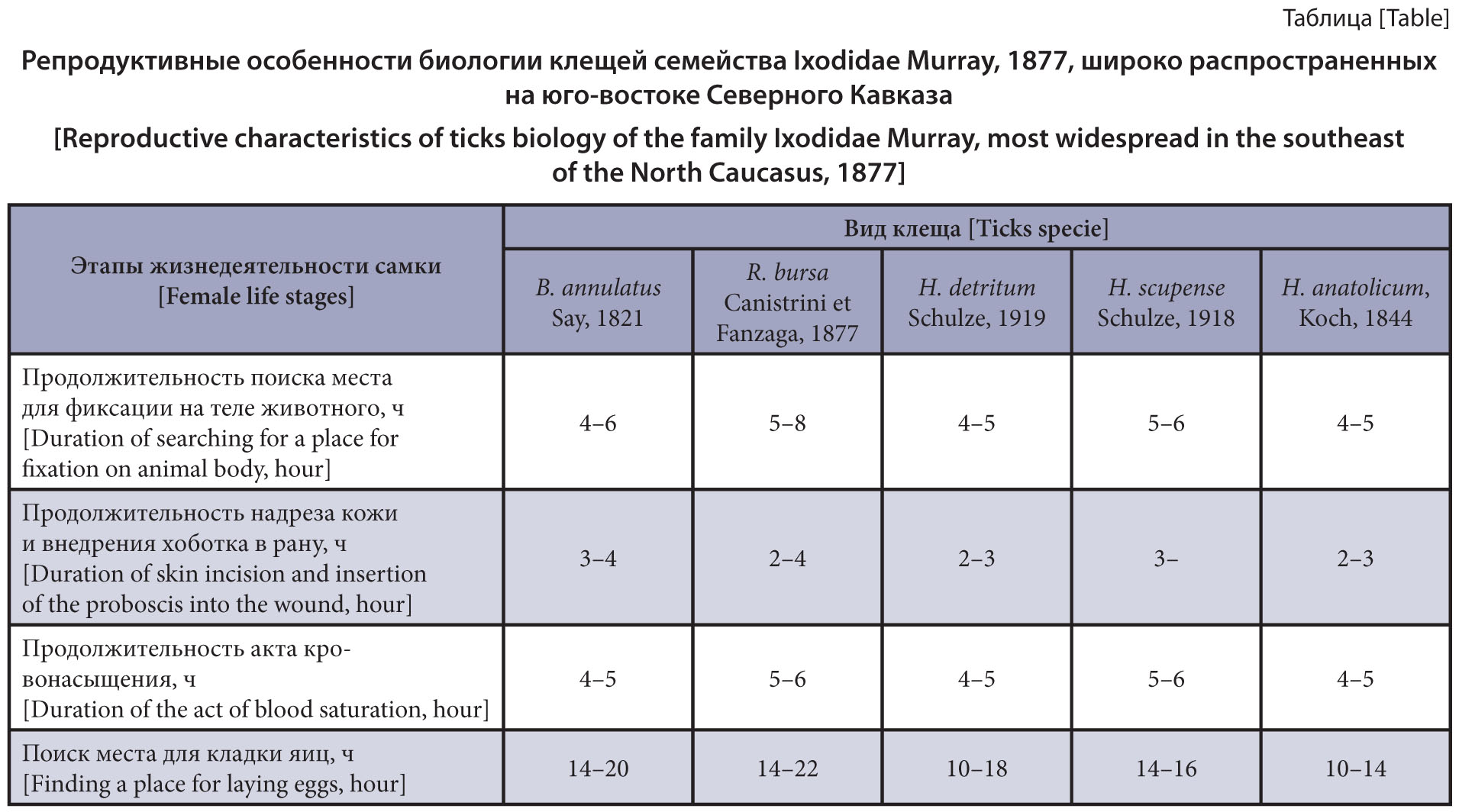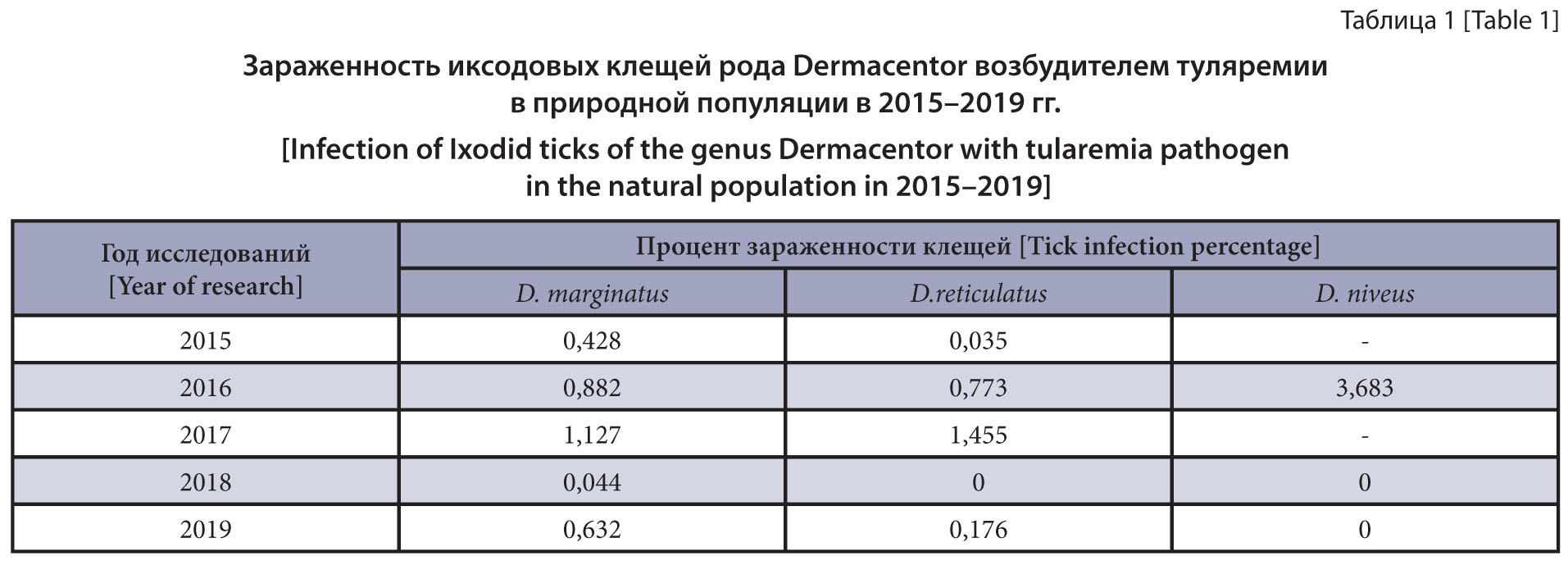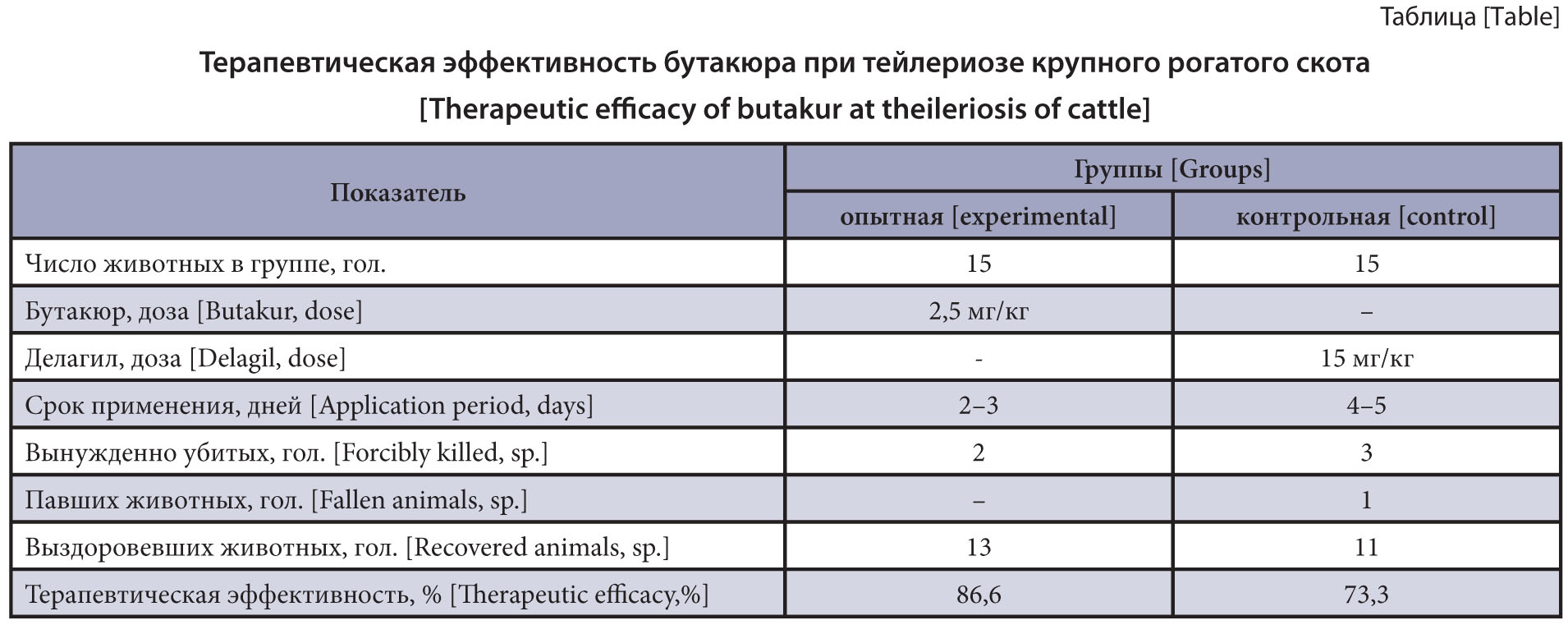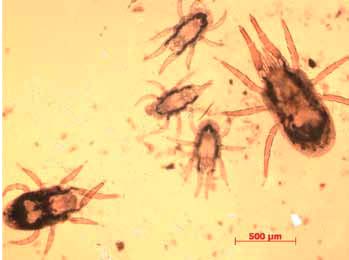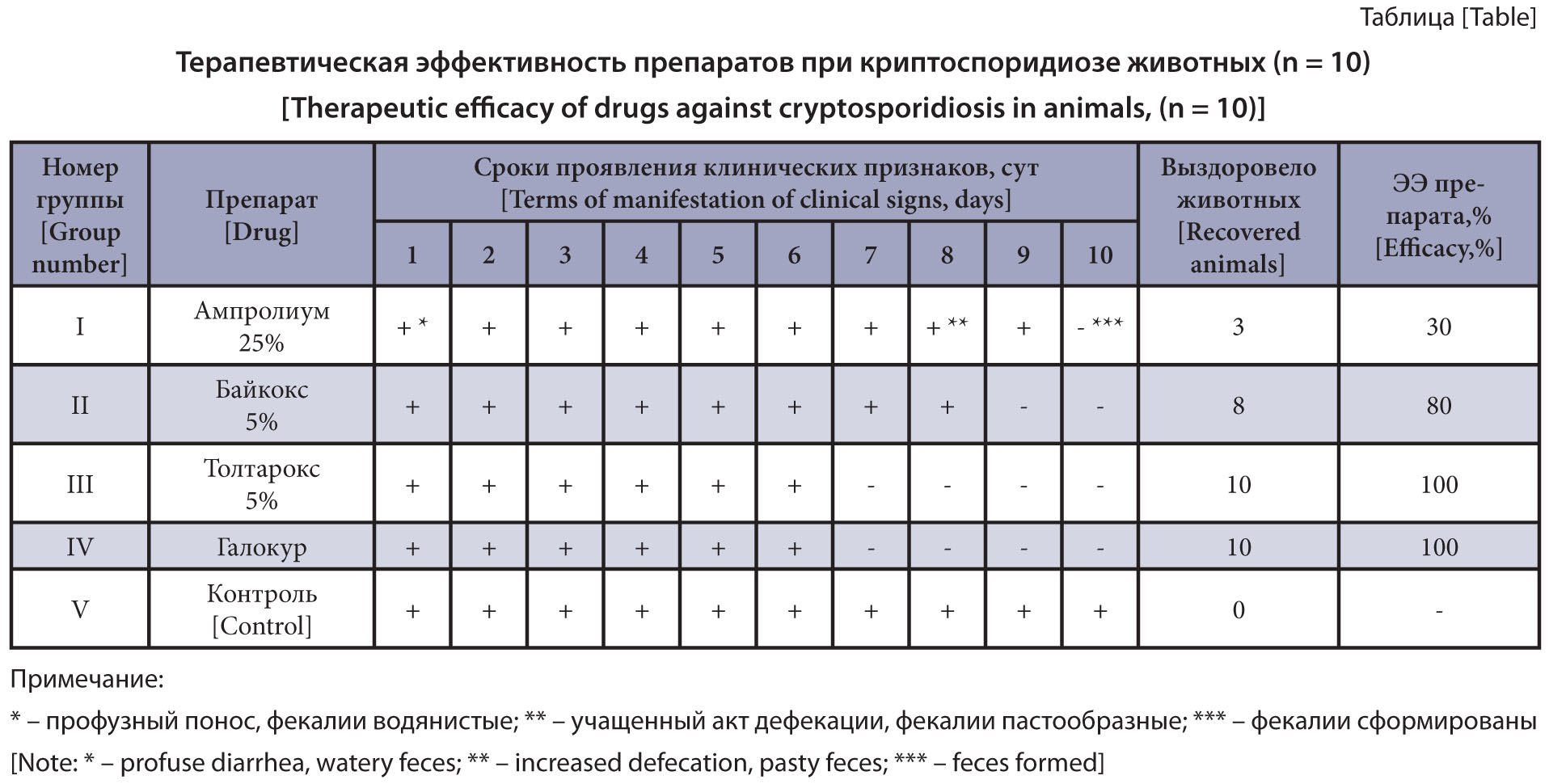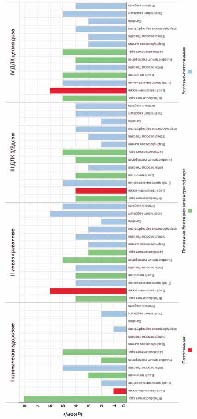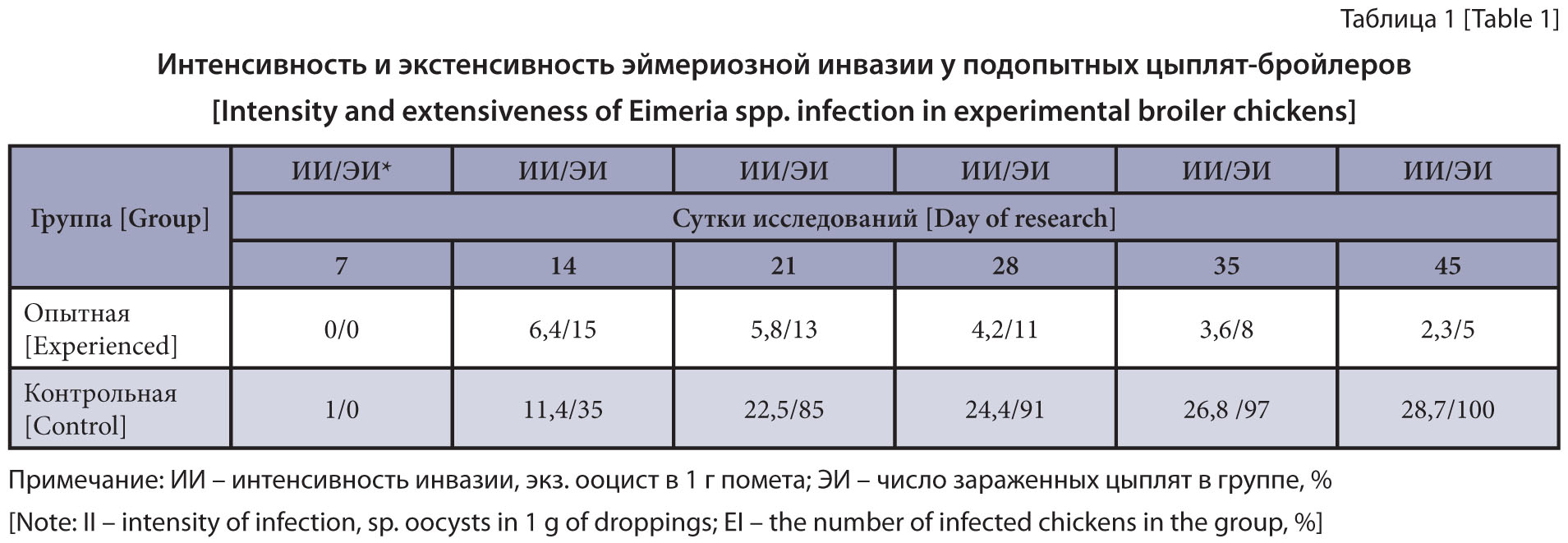FAUNA, MORPHOLOGY AND SYSTEMATICS OF PARASITES
The purpose of the research is study of pinniped helminth fauna in Chukotka, and the analysis of the fish of the main commercial families infected with pathogens of helminthozoonoses based on modern literature.
Materials and methods. The helminths were collected in autumn of 2019 from pinnipeds caught in the Mechigmenskaya Guba of the Bering Sea in the Chukotka Autonomous Okrug by the method of partial helminthological dissection per Skryabin (gastrointestinal tract). Samples were examined from 6 walruses and 26 seals (13 spotted seals and 13 ringed seals). The helminths found were fixed in 70% alcohol. The helminth species were identified at the Department of Parasitology and Veterinary and Sanitary Examination of the MVA named after K. I. Skryabin using reference literature.
Results and discussion. All pinnipeds were infected with nematodes of the family Anisakidae. Mature Pseudoterranova desipiens were found in the walrus (Infection Prevalence = 16.7% with Infection Intensity = 3 specimens/animal), mature Ps. desipiens, as well as Contracoecum osculatum and Anisakis simplex larvae (IP = 30.8% with II from 5 to 57 specimens) were found in the spotted seal, and Ps. desipiens larvae and mature Ps. desipiens were found in the ringed seal (IP = 15.4% with II from 1 to 4 specimens). Thus, only Ps. desipiens were represented by mature stages (females and males), and two other species of anisakids, C. osculatum and A. simplex, were found in the seals in the larval stage.
ECOLOGY AND BIOLOGY OF PARASITES
The purpose of the research is study of some reproductive characteristics of the biology of ticks of the family Ixodidae which are widespread in the southeast of the North Caucasus.
Materials and methods. In 2000–2010, 9 series of experiments were carried out in the conditions of the plain belt in Dagestan. The first, second, and third series of experiments were intended to find out the duration of the tick searching for a place to fix on the animal, the duration of the skin incised and the proboscis inserted into the wound, and the engorgement duration; and the fourth series was intended to clarify the tick wintering on the animal. Such experiments were performed on two-year-old calf bulls on the Educational and Experimental Farm of the Dagestan State Agrarian University with Boophilus annulatus, Rhipicephalus bursa, Hyalomma detritum, H. scupense, and H. anatolicum in 2000. Five hungry adult female ticks were placed onto all 5 calf bulls in the middle third of the neck. We conducted experiments on searching for a place for egg-laying, egg-laying duration in the environment, number of eggs in a clutch, duration of the larva formed and the hatching rate, distance of the larvae from the hatching place, and larvae death rate in five specially equipped sites of pastures of 1 m2 . Five adult female ticks of B. annulatus, R. bursa, H. detritum, H. scupense, and H. anatolicum were placed after engorgement in each biological site.
Results and discussion. Ixodid ticks perform their natural physiological functions associated with feeding and reproduction with significant time fluctuations. The search for a place to fix on the animal took 4–8 hours; the skin incised and proboscis inserted in the wound took 2–5 hours; the engorgement took 4–6 hours; the search for an egg-laying place took 10– 22 hours; the egg-laying duration in the environment was 18–23 hours; the number of eggs in a clutch was 4–13K; the duration of the larva formed and the hatching rate was 10–15 days and 58.0–75% respectively; the distance of the larva from the hatching place was 0.5–1.5 m; death rate of the larva in captivity was 100%; and the tick wintering on the animal was near the neck, ears, in the dewlap, the flank and the udder. These features are typical for the analyzed tick species in the southeast of the North Caucasus and, probably, for other taxa of these genera.
The purpose of the research is the assessment of the Francisella tularensis occurrence in nature in ticks of the genus Dermacentor; understanding the physiological age in terms of tick infection with tularemia pathogen.
Materials and methods. For the period from 2015 to 2019, we examined 8449 specimens of Dermacentor marginatus (916 pools), 8674 specimens of D. reticulatus (705 pools), and 109 specimens of D. niveus (40 pools) for tularemia infection. To assess the dependence of tularemia pathogen found in ticks of different physiological ages, we examined 2440 specimens of D. marginatus (360 pools), and 3349 specimens of D. reticulatus (412 pools) for the period from 2016 to 2019. Studies of ixodid ticks infected with tularemia pathogen were performed by the Natural Focal Infection Laboratory of the Stavropol Anti-Plague Institute. Pools of ixodid ticks were examined for the pathogen DNA of tularemia using reagent kits for identifying Francisella tularensis DNA by polymerase chain reaction with fluorescence hybridization of results recorded in real time.
Results and discussion. The infection rate of the tularemia pathogen in ticks in the Central Pre-Caucasian region ranged from 0.044–1.127% in D. marginatus and 0.035–1.455% in D. reticulatus in different years. The greatest number of F. tularensis was isolated from the III physiological age ticks. For D. reticulatus ticks, no statistically significant dependence of the detected tularemia pathogen on physiological age was found.
EPIZOOTOLOGY, EPIDEMIOLOGY AND MONITORING OF PARASITIC DISEASES
The purpose of the research is studying the oribatid mite biodiversity on the Dagestan pastures in terms of altitudinal zonation and their infection with Moniezia sp. procercoids.
Materials and methods. Oribatid mites were collected in different seasons of 1990–2020 on different types of pastures of the plain, foothill, and mountain belts of Dagestan. A total of 16,000 specimens of oribatid mites were collected. 120 sets of lamb intestines were dissected. Oribatid mites were collected using the Tulgren funnel. The method of complete helminthological dissection according to K. I. Skrjabin was used in the work.
Results and discussion. On low-lying wet pastures of the flat belt, up to 5800 oribatid specimens were recorded per 1 m² with 38.0% prevalence of infection (PI) with moniezia cysticercoids; 675 specimens were collected on the steppe lands with the PI of 12.5%, up to 140 specimens were collected on salt marshes with the PI 0.9%, and 52 specimens were collected in the semi-deserts with the PI 0.4%. In the foothill steppes, 1,300 oribatids specimens were found per 1 m² with their procercoid infeсtion up to 18.0%, 2100 specimens with 16.0% were collected along river valleys, and 120 specimens with the PI of 0.5% on mountain plateaus. Lambs on low-lying wetlands of the lowland belt were infected with Moniezia sp. by 72.0% with the infection intensity (II) of 8-116 specimens, on steppe pastures by 67.5% at the II of 5–36 specimens, on salt marshes by 18.0% with the II of 2–8 specimens, and in semi-deserts by 12.0% with the II of 2–5 specimens. In the foothill steppes, lambs were infected with Moniezia sp. by 68.0% with the II of 9–64 specimens, along river valleys by 69.0% with the II of 11–62 specimens, and on mountain plateaus by 12.0% with the II of 2–4 specimens.
PHARMACOLOGY, TOXICOLOGY
The purpose of the research is to develop a methodology for the quantitative determination of fenbendazole (FBZ) and its metabolites in organs and tissues of sheep by high performance liquid chromatography tandem mass-spectrometry (HPLC-MS/MS).
Materials and methods. The method for determining of FBZ and its metabolites after the administration of the supramolecular complex of fenbendazole was validated in accordance with international guidelines for the following indicators: linearity, recovery, specificity, precision, accuracy, limits of quantitative and qualitative determination.
Results and discussion. The method of quantitative analysis of FBZ and its metabolites sulfone and sulfoxide in the body of sheep after the administration of the supramolecular complex has been adapted. The proposed method has a linear relationship (R > 0.99) in the range of 5–1000 ng / g and has shown a good reproducibility and accuracy.
TREATMENT AND PREVENTION
The purpose of the research is studying therapeutic properties of Butakur against spontaneous bovine theileriosis.
Materials and methods. Butakur was used on the Yalgin Farm and at the Umarov Agricultural Enterprise in the Karabudakhkentskiy District to treat 30 animals in the early stage of the disease at a body temperature of 40.4–41.7 0C and a parasitic reaction of 30.2%. Piroplasmids were differentiated by microscopy of smears, imprints of lymph nodes and peripheral blood, and by detected purple bodies and parasites in them, excluding mixed infection. Two groups of animals were formed on the principle of analogs. In the test group (n = 15), Butakur was used as a specific therapy at a dose of 2.5 mg/kg for the active substance at a rate of 1 ml/20 kg of body weight, and the antimalarial drug Delagil (chloroquine) was used in the control group at a dose of 15 mg/kg within 4–5 days. A different combination of chemotherapy drugs with symptom-directed and pathogenetic drugs was used simultaneously.
Results and discussion. Butakur was the most effective when used in the early period of the disease development from the moment the body temperature rose and until a slight parasitemia in erythrocytes was observed with the simultaneous use of symptom-directed and pathogenetic drugs. Out of 15 animals that received Butakur at a dose of 1 ml/20 kg (2.5 mg/kg for the active substance), 13 animals recovered, and the efficacy was 86.6%.
The purpose of the research is developing a methodology for application of the supramolecular complex of fenbendazole (SMCF) against helminthosis in ruminants.
The SMCF was obtained by the method of mechanochemical technology with polyvinylpyrrolidone (PVP) in a ratio of 1 : 10 in a balling drum. The drug was produced in plastic cans of 2, 4 and 8 kg and stored in its original packaging in dry, nonresidential area. The SMCF was used against gastrointestinal strongylatosis, dictyocaulosis and monieziosis of sheep and goats at a dose of 20 mg/kg (2 mg/kg for the active substance). The methodology provides a brief chemical characteristic of the SMCF, summarizes its mode of action, and describes toxicological properties, which gives an idea of the drug in general. The procedure is described for preparing the drug for use on animals, both individually and in a group. Reasoned recommendations are given on the timing for animal slaughter, and the use of milk after treating cows.
The purpose of the research is to study the efficacy of the insectoacaricide "5% D-cyphenotrine emulsion" against infestation of birds with Dermanyssus gallinae (dermanyssosis) after the deacarization of the poultry building and to characterize physiological and biochemical mechanisms of the recovery of Hy-Line hens after removed parasites.
Materials and methods. A parasitological examination of the poultry farm found D. gallinae in one of the poultry buildings. Given positive results of the drug efficacy against the poultry red mite, we analyzed the morpho-physiological and physiological and biochemical parameters of the hen’s blood before and 10 and 20 days after the treatments. Changes in the ethological status of birds were recorded. We used 0.005% aqueous emulsion of "5% D-cyphenothrin emulsion" for treatment. To obtain it, the drug was diluted with water at a ratio of 1:1000 immediately before use.
Results and discussion. After double treatment with "5% D-cyphenotrine emulsion" of the shop with hens from the test group, no live poultry red mite was found. Within 20 days after the disease reduction, representatives of this group showed high concentrations of cortisol which were 2.3–2.4 times (p < 0.001) higher than those of healthy hens. This indicates that the stress state of hens still remains after the parasitizing of D. gallinae. In addition, the recovery process takes a long time and with great stress for all systems of their body. This is also confirmed by a high level of lipid peroxidation. At the same time, high intensity of gluconeogenesis and, as a result, deterioration of lipid and protein metabolism were recorded in the hens in question. The positive results indicate an increasing need for additional energy expenditures which are paramount for the effective and well-timed implementation of adaptation mechanisms. It should be noted here that the values of all the above-mentioned indicators tend to normalize by the end of the study period. The changes noted in the blood of birds indicate the restoration of a number of body systems. The poultry red mite as an emergency factor affects the morphophysiology of the blood, in particular, the level of white blood cells, which is restored by the 10th day after deacarization, which triggers regenerative and reparative processes. There were also changes in the number of cells of the immune system, an increase in hemoglobin concentration to control values and optimization of behavior in representatives of the test group which are largely related to the normalized physiological activity of the thyroid gland after the poultry building deacarization. We found a partial recovery of the hen’s body systems after the poultry building deacarization with the drug "5% D-cyphenotrine emulsion", which is due to the long-term parasitizing of D. gallinae, a stressor of extreme strength.
The purpose of the research is studying the spread of cryptosporidiosis in calves and assessment of the extenseeffectiveness of antiprotozoal drugs.
Materials and methods. The spread, seasonal and age-specific trends of cryptosporidiosis was studied on 395 spontaneously infected animals of five age groups. The first group was formed of calves up to 10 days of age, the second group of calves aged from 11 days to 2 months, the third group of calves from 2 to 4 months, the fourth group of calves from 4 to 6 months of age, and the fifth group of young animals from 6 months up to 1 year. To assess the efficacy of various drugs against cryptosporidiosis in calves, 5 groups of infected animals (4 experimental and 1 control), 10 animals each, were formed according to the principle of analogous pairs. The infection rate in cattle was determined by generally accepted coprological flotation methods, as well as by native smears with further staining according to Ziehl-Nielsen. We also considered clinical signs of cryptosporidiosis (diarrhea, dehydration).
Results and discussion. We established the widespread occurrence of cryptosporidiosis in cattle on the farms of the Igrinsky, Uvinsky, Zavyalovsky Districts of the Udmurt Republic. The infection rate ranged from 20.25 to 80.0%. The largest percentage of infected calves was observed in the winter-spring period which was associated with the synchronization of the reproductive cycles of cows and a decrease in the resistance of the animal organism. Toltarox 5% and Galokur drugs in work environments showed 100% extense-effectiveness. It is not recommended to apply Amprolium 25% on these farms due to the low efficacy and the development of parasite resistance to this drug.
The purpose of the research is evaluating the efficacy of complex therapy using dironet, lactobifadol and keratin food supplement (DLK) against toxascariosis of the arctic fox.
Materials and methods. To determine the helminth fauna in the conditions of Vyatka Fur Breeding Farm, 61 females silver fox and 55 females voilevoy arctic fox were used as study objects. To conduct complex therapy against toxascariosis, the study object was 24 females culled from the breeding herd, spontaneously infected with toxascariosis and being clinically healthy. The morphological and biochemical blood parameters in female foxes were determined before and after dehelminthization, and control weighing of animals from experimental groups was carried out before and after the experiment.
Results and discussion. Of the studied 116 fur-bearing animals, 26 (22.4%) were infected with Toxascaris leonina. Infection rate of Toxascaris sp. in silver fox females aged 5–7 years was 42.6% when 7-9 eggs were found in one microscope field (magnification 7 × 9). Infection with Toxascaris sp. affects on the body weight of infected animals. The females silver fox from the second experimental group infected with Toxascaris sp., which were not treated, had an average live weight of 1.3 kg less (16.6%) as compared to the control. The complex therapy with the DLK treatment-and-prophylactic complex contributed to the improved metabolic processes and digestion. The applicability of the DLK treatment-and-prophylactic complex for therapy against toxascariosis was proved.
The purpose of the research is determining the effect of the therapeutic and prophylactic complex of Dironet, Lactobifadol and fodder Keratin (DLK) on the qualitative and quantitative composition of the intestinal microflora affected by toxascariosis in the Blue Frost fox.
Materials and methods. The research was carried out on the Fur Breeding Farm “Vyatka”, Slobodskoy District, the Kirov Region. The study objects were 24 female Blue Frost foxes culled from the breeding herd. To determine the quality of the skins obtained from the experimental animals, we sorted flint-dried skins.
Results and discussion. After the introduction of the therapeutic and preventive complex DLK into the diet of sick animals, the positive dynamics was observed in the quantitative and qualitative composition of intestinal microorganisms. In animals of the experimental groups that were administered DLK, the number of bifidus bacteria, lactic bacteria and fecal enterococci increased; there was a significant decrease or complete absence of pathogenic and conditionally pathogenic microorganisms, fusobacteria, streptococci, clostridia, typical lactose-negative and hemolytic Escherichia, aureus and saprophytic staphylococcus, common Proteus and fungi of the Candida genus. In animals infected by Toxascaris leonina that did not receive the complex therapy, a decrease in lactic acid bacteria and an increase in the content of pathogenic and commensal microorganisms were noted. Under the output of the fur production, the infected animals showed the lowest percentage of skins in terms of quality of 7.16%, which was 0.38% less in comparison with healthy foxes, and 0.51% less in comparison with treated Blue Frost foxes.
The purpose of the research is efficacy evaluation of the anticoccidial drug Solycox combined with the feed additive Chiktonik against avian eimeriosis.
Materials and methods. The experiments were carried out on the Makhachkalinskaya poultry farm, which was contaminated with eimeriosis, on healthy 1 day old Ross-308 broilers. Two groups were formed from the selected chickens, test and control, 50 birds each. From the first day of life, broiler chickens from the test group were administered Solycox at a dose of 2 ml per 1 liter of drinking water combined with the feed additive Chiktonik at the rate of 1 ml per 1 liter of drinking water. The control chickens were not prescribed any anticoccidial drug or feed additive.
Results and discussion. We established high efficacy of Solycox combined with Chiktonik against eimeriosis of broiler chickens (96%). Solycox combined with Chiktonik contributes to the poultry viability and resistance to the disease, and has a positive effect on productivity. The results of the studies allow us to recommend Solycox and Chiktonik to prevent and treat eimeriosis of broiler chickens.
The purpose of the research is developing a method for disinfection of environmental objects against coccidia oocysts in broiler chickens.
Materials and methods. At the VNIIP – FSC VIEV vivarium, a bioassay test was performed to experimentally infect 60 chickens aged 14 days which were divided into six equivalent groups of 10 birds each and kept isolated in cages. Chickens from the first, second and third groups were administered orally, using a micropipette, 1 ml of an Eimeria oocyst suspension treated with 4, 5 and 6% solutions of the combined eimeriocide agent. Chickens from the fourth group were administered 1 ml of Eimeria oocyst suspension treated with 4% phenol solution (base drug). Chickens from the fifth group received 1 ml of a buffered solution and were used as a noninfected control. Chickens from the sixth group received 1 ml of suspension containing 2000 oocysts/mL and were used as an infected control. The efficacy of disinfection with eimeriocide and the basic drug was determined based on the percentage of decrease in the recovery of Eimeria oocysts after being exposed to drugs as compared to chickens of the infected control. The efficacy of 5% eimeriocide against poultry coccidia oocysts in a production test was determined empirically with the set of oocysts on control sites as compared with the basic drug on a poultry farm in the Moscow Region.
Results and discussion. The intense-effectiveness of 4% eimeriocide against coccidia oocysts was 99.31%, and the 5 and 6% combined agent showed 100% efficacy. The basic drug, 4% phenol showed 74.65% intense-effectiveness. The results obtained in the production test of 5% eimeriocide at a dose of 0.5 l per 1 m2 with a 2 hour-exposure indicate its high efficacy for disinfection against coccidia oocysts in broiler chickens. The intense-effectiveness was 97.25% versus 59.03% efficacy of the base drug, phenol.
ISSN 2541-7843 (Online)



